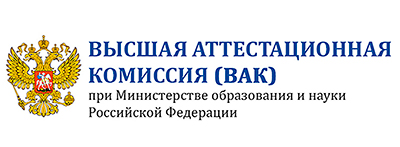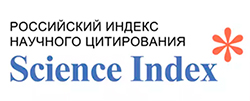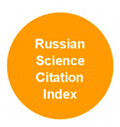Cities of over a million people on the mortality map of Russia
Abstract
The problem of excess mortality in Russia has not lost its relevance. The situation is complicated by the high level of spatial inequality in health, which is usually measured at the regional level in our country. This work is one of the first attempts to look at the dynamics and extent of spatial inequality in health in Russia at the sub-regional level, by contrasting the "center/core" (in our case, represented by the largest Russian cities) with the "periphery" (the rest of the country). Cities with a population of over a million people were chosen based on the spatial hierarchy that exists in Russia, according to which the highest level of social and economic development is concentrated in the largest cities. As a rule, a higher level of development of human capital corresponds to lower mortality. Using data provided by Rosstat, we calculated life expectancy at birth for Russian cities with a population of over a million people in 1989-2016. The results fully coincided with our expectations: the polarization in the health levels between the largest Russian cities and the rest of the country has significantly increased in the last twenty-five years, which is a reflection of those centripetal processes that have been taking place in our country during this period. Russian cities with a population of over a million people are attractive destinations for both internal and external migrants, and thus acquire, among other things, a much more educated population. Since people with higher education take better care of their health, having a more educated population is undoubtedly an essential advantage of bigger cities over the periphery when it comes to the overall health level. Without solving the structural problems that restrain social and economic development outside the largest agglomerations, convergence in mortality rates between cities with a population of over a million people and the surrounding territories is hardly possible.
Downloads
References
Andreev E., V.M. Shkolnikov, T. Valkonen, A. Begun (2001). Measuring inter-group inequalities in length of life // Genus. 57(3-4): 33-62.
Andreev E.M. (1979). Prodolzhitel'nost' zhizni v SSSR: differentsial'nyy analiz [Life expectancy in the USSR: differential analysis] // Prodolzhitel'nost' zhizni: analiz i modelirovanie [Lifespan: Analysis and Modeling]. Moscow: Statistika: 7-31.
Andreev E.M. (2012). O tochnosti rezul'tatov rossiyskikh perepisey naseleniya i stepeni doveriya k raznym istochnikam informatsii [On the accuracy of the results of Russian population censuses and the level of confidence in different sources of information] // Voprosy statistiki [Issues of Statistics]. 11: 21–35.
Andreev E.M., E.A. Kvasha, T.L. Kharkova (2006). Osobye tochki na karte smertnosti [The special points on the map of mortality] // Naselenie Rossii 2003–2004 [Population of Russia 2003–2004]. Odinnadtsatyy-dvenadtsatyy ezhegodnyy demograficheskiy doklad [Eleventh-twelfth annual demographic report] / A.G. Vishnevsky, ed. Moscow: 298–305.
Andreev E.M., E.A. Kvasha, T.L. Kharkova (2016). Smertnost' v Moskve i drugikh megapolisakh mira: skhodstva i razlichiya [Mortality in Moscow and other megacities of the world: similarities and differences] // Demograficheskoe obozrenie [Demographic Review]. 3(3): 39-79.
Andreev E.M., V.M. Shkolnikov (2018). Svyaz' mezhdu urovnyami smertnosti i ekonomicheskogo razvitiya v Rossii i ee regionakh [The relationship between mortality and economic development in Russia and its regions] // Demograficheskoe obozrenie [Demographic Review]. 5(1): 6–24.
Cochrane SH., DJ. Ohara, J. Leslie (1980). The effects of education on health. Washington, D.C., World Bank. 95 p. (World Bank Staff Working Paper №405.)
Demograficheskaya situatsiya v Moskve i tendentsii ee razvitiya [The demographic situation in Moscow and its development trends] (2006) / L.L. Rybakovsky, ed. Moscow: TsSP. 264 p.
Eberstadt N. (1981). The health crisis in the USSR // New York Review Books: 23-21. (Reprinted Int J Epedemiol 2006; 35:1384-94.)
Grigoriev P., F. Meslé, V.M. Shkolnikov, E. Andreev, A. Fihel, M. Pechholdova et al. (2014). The recent mortality decline in Russia: Beginning of the cardiovascular revolution? // Population and Development Review. 40(1): 107–129.
Grigoriev P., G. Doblhammer-Reiter, V.M. Shkolnikov (2013). Trends, patterns, and determinants of regional mortality in Belarus, 1990–2007 // Population Studies-A Journal of Demography. 67: 61-81.
Kalediene R., J. Petrauskiene (2000). Regional life expectancy patterns in Lithuania // European Journal of Public Health. 10(2):101–104.
Kalediene R., J. Petrauskiene (2004). Socio-economic transition, inequality, and mortality in Lithuania // Economics and Human Biology. 2(1):87–95.
Kharkova T.L., S.Yu. Nikitina, E.M. Andreev (2017). Zavisimost' prodolzhitel'nosti zhizni ot urovnya obrazovaniya v Rossii [The dependence of life expectancy on the level of education in Russia] // Voprosy statistiki [Issues of Statistics]. 8: 61–68.
Krumins J., D. Jasilionis, L. Mall, V. Stankuniene (2009). Changes of geographical mortality differences in the three Baltic countries during the period of socio-economic transformation. Paper presented at the IUSSP 26th International Population Conference, Marrakech.
Kvasha E.A. (2008). Differentsiatsiya mladencheskoy smertnosti po urovnyu obrazovaniya materi v regionakh Rossii v kontse 80-kh - seredine 90-kh godov 20 veka [Differentiation of infant mortality by the level of education of the mother in the regions of Russia in the late 80s - mid 90s of the 20th century] // Demoscope Weekly. 331–332. URL: http://www.demoscope.ru/weekly/2008/0331/analit06.php (accessed: 04.11.2018).
Kvasha E.A., T.L. Kharkova (2009). Rossiyane i moskvichi ne ravny pered litsom smerti [Russians and Muscovites are not equal in the face of death] // Demoscope Weekly. 369–370. URL: http://demoscope.ru/weekly/2009/0369/tema01.php (accessed: 04.11.2018).
Marmot M.G., A.M. Adelstein, L. Bulusu (1984). Lessons from the study of immigrant mortality // Lancet. 2: 1455-1457.
Mkrtchyan N.V. (2012). Problemy ucheta naseleniya otdel'nykh vozrastnykh grupp v khode perepisi naseleniya 2010 g.: prichiny otkloneniy poluchennykh dannykh ot ozhidaemykh [Problems of registration of the population of certain age groups during the 2010 census: reasons for deviations of the data from the expected] // Demograficheskie aspekty sotsial'no-ekonomicheskogo razvitiya [Demographic aspects of socio-economic development]. Iss. 22. / M.B. Denisenko, ed. Moscow: MAKS Press: 197–214.
Neravenstvo i smertnost' v Rossii [Inequality and Mortality in Russia] (2000) / V.M. Shkolnikov, E.M. Andreev, T.M. Maleva, eds. Moscow: Signal. 123 p.
Papanova E.K., V.M. Shkolnikov, E.M. Andreev, S.A. Timonin (2017). Vysokaya prodolzhitel'nost' zhizni moskvichey posle 80 let – real'nost' ili statisticheskiy artefakt? [High life expectancy of Muscovites after 80 years - a reality or a statistical artifact?] // Uspekhi gerontologii [Advances in gerontology]. 6: 826–835.
Preston S.H. (2007). The changing relation between mortality and level of economic development // International Journal of Epidemiology. 36 (3): 484–90.
P'yankova A.I., T.A. Fattakhov (2017). Smertnost' po urovnyu obrazovaniya v Rossii [Mortality by level of education in Russia] // Ekonomicheskij zhurnal VSHE [HSE Economic Journal]. 21(4): 623–647.
Razum O., H. Zeeb, S. Rohrmann (2000). The ‘healthy migrant effect’–not merely a fallacy of inaccurate denominator figures // International Journal of Epidemiology. 29(1):191–192.
Semenova V.G. (2005). Obratnyy epidemiologicheskiy perekhod v Rossii [Reverse epidemiological transition in Russia] (2005). Moscow. 235 p.
Shchur A. (2018). Tendentsii smertnosti v rossiyskikh gorodakh s chislennost'yu naseleniya svyshe odnogo milliona chelovek (1989-2016 gg.) [Mortality trends in Russian cities with a population of over one million people (1989-2016)]: master thesis. Moscow: NRU HSE.
Shkaratan O.I. (2009). Sotsial'no-ekonomicheskoe neravenstvo i ego vosproizvodstvo v sovremennoy Rossii. [Socio-economic inequality and its reproduction in modern Russia] Moscow: Olma Media Grupp. 556 p.
Shkolnikov V.M. (1987). Geograficheskie faktory prodolzhitel'nosti zhizni [Geographical factors of life expectancy] // Izvestiya AN SSSR. Seriya Geograficheskaya [News of the USSR Academy of Sciences. Geographical series]. 3(12): 35-44.
Shkolnikov V.M., E. Andreev, D. Jdanov, J. Vallin, F. Meslé, C. Boe, J. Wilmoth, S. Gellers-Barkmann (2017). Methodology note for the Life Table Database (LTDB). URL: http://www.lifetable.de/methodology.pdf (accessed: 05.11.2018).
Shkolnikov V.M., A.D. Deev, Ø. Kravdal, T. Valkonen (2004). Educational differentials in male mortality in Russia and northern Europe. A comparison of an epidemiological cohort from Moscow and St. Petersburg with the male populations of Helsinki and Oslo // Demographic research. 10(1): 1-26.
Shkolnikov V.M., E. Andreev, D. Jasilionis, M. Leinsalu, O. Antonova, M. McKee (2006). The changing relation between education and life expectancy in central and eastern Europe in the 1990s // Journal of Epidemiology and Community Health. 60(10): 875-881.
Shkolnikov V.M., E. Andreev, M. McKee, D.A. Leon (2013). Components and possible determinants of decrease in Russian mortality in 2004–2010 // Demographic Research. 28(32): 917–950.
Shkolnikov V.M., G.A. Cornia, D.A. Leon, F. Meslé (1998). Causes of the Russian mortality crisis: evidence and interpretations // World Development. 26(11): 1995–2011.
Shkolnikov V.M., S. Vasin (1994). Spatial differences in life expectancy in European Russia in the 1980s. // Demographic trends and patterns in the Soviet Union before 1991 / W. Lutz, S. Scherbov, A. Volkov, eds. London: Routledge: 379–402.
Timonin S., A. Kontsevaya, M. McKee, D.A. Leon (2018). Reducing geographic inequalities in access times for acute treatment of myocardial infarction in a large country: the example of Russia // International Journal of Epidemiology. 47(5): 1594-1602.
Timonin S., I. Danilova, E. Andreev, V.M. Shkolnikov (2017). Recent mortality trend reversal in Russia: are regions following the same tempo? // European Journal of Population. 33(1): 733-763.
Vallin J., E. Andreev, F. Meslé, V.M. Shkolnikov (2005). Geographical diversity of cause-of-death patterns and trends in Russia // Demographic Research. 12(13): 323–380.
Vasin, S., C.A. Costello (1997). Spatial, age, and cause-of-death patterns of mortality in Russia, 1988–1989 // Premature Death in the New Independent States / J.L. Bobadilla, C.A. Costello, F. Mitcell, eds. Washington, DC: National Academies Press: 66–119.
Vishnevsky A., Shkolnikov V. (1997). Smertnost' v Rossii: glavnye gruppy riska i prioritety deystviya (Mortality in Russia: main risk groups and priorities of action). Nauchnye doklady Moskovskogo Tsentra Karnegi (Scientific reports of the Moscow Carnegie Center), Issue 19. Carnegie Endowment for International Peace: 83 p.
Vishnevsky A. (2015). Mortality in Russia: the second epidemiological revolution that never was // Demographic Review, English selection: 4-33.
Walberg P., M. McKee, V.M. Shkolnikov, L. Chenet, D.A. Leon (1998). Economic change, crime and Russian mortality crisis: a regional analysis // British Medical Journal. 317(7154): 312–318. (accessed: 10.08.2018).
Zubarevich N.V. (2010). Goroda kak tsentry modernizatsii ekonomiki i chelovecheskogo kapitala [Cities as centers of economic modernization and human capital] // Obshchestvennye nauki i sovremennost [Social Sciences and Contemporary World]. 5: 5–19.




















